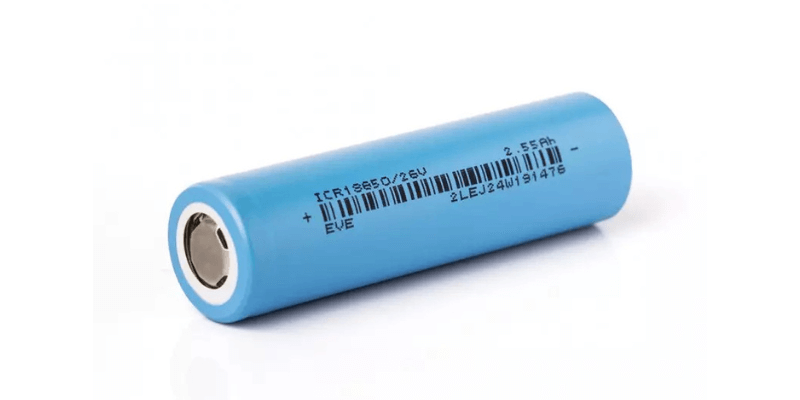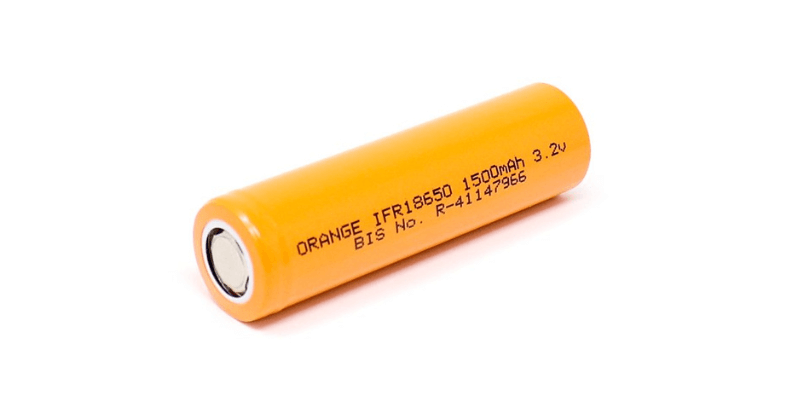Compreender as diferenças entre as baterias IMR, ICR, INR e IFR 18650 é essencial para um uso ideal. Cada tipo tem uma composição química e perfil de desempenho distintos. Este artigo fornece uma análise detalhada de cada tipo de bateria, destacando seus atributos e aplicações exclusivos.
Bateria IMR 18650
Composição Química
IMR significa Óxido de Lítio Manganês (LiMn2O4), um material catódico usado em baterias de íon de lítio. O “R” indica seu alto teor de manganês.
Vantagens
- Segurança aprimorada: O óxido de lítio-manganês é estável, reduzindo fuga térmica riscos e melhorando a estabilidade durante os ciclos de carga e descarga.
- Alta taxa de descarga: As baterias IMR têm menor resistência interna, permitindo taxas de descarga mais altas, tornando-as perfeitas para dispositivos que consomem muita energia, como mods vaping.
Desvantagens
- Baixa capacidade: As baterias IMR podem estar fracas densidade de energia do que algumas outras variantes do 18650, o que pode reduzir a vida útil ou a capacidade da bateria em aplicações de baixo consumo de energia.
Aplicativos
As baterias IMR 18650 são amplamente utilizadas em dispositivos que requerem produção imediata de energia:
- Cigarros Eletrônicos: Sua capacidade de descarga rápida os torna populares na comunidade vaping para rajadas rápidas de vaporização.
- Sistemas de iluminação portáteis: Lanternas de alto desempenho se beneficiam de baterias IMR’ capacidade de fornecer alta potência imediata.
- Ferramentas elétricas: Dispositivos que necessitam de rajadas de energia substanciais, como furadeiras e serras, consideram as células IMR adequadas para seus requisitos de alto consumo.

Bateria ICR 18650
Composição Química
ICR significa Óxido de Lítio-Cobalto (LiCoO2), um material catódico usado em baterias de íon-lítio.
Vantagens
- Alta capacidade: As baterias ICR têm uma densidade de energia notável, permitindo-lhes armazenar mais energia do que muitas outras baterias 18650.
Desvantagens
- Preocupações de segurança: A química do óxido de lítio-cobalto apresenta riscos de segurança, especialmente durante cenários de alto consumo. As baterias ICR são mais suscetíveis ao superaquecimento e à instabilidade, tornando o gerenciamento da segurança crítico.
- Estabilidade inferior: As baterias ICR apresentam maior risco de explosão ou incêndio do que outros tipos 18650 devido ao uso de um cátodo de óxido de lítio-cobalto, que é menos estável.
- Taxas de descarga mais baixas: Essas baterias descarregam mais lentamente do que variantes como IMR, limitando seu uso em aplicações de alto consumo.
Aplicativos
As baterias ICR 18650 são usadas em dispositivos que priorizam alta capacidade em relação à saída de energia imediata.
- Eletrônicos de consumo: Laptops, câmeras digitais e eletrônicos portáteis se beneficiam das baterias ICR’ potência estável e duradoura.
- Dispositivos de baixo consumo: Gadgets como dispositivos médicos e lanternas de baixo consumo usam baterias ICR para energia sustentada.

Bateria INR 18650
Composição Química
INR significa Óxido de Lítio-Níquel-Manganês-Cobalto (Li-NiMnCoO2), um material catódico usado em baterias de íon-lítio.
Vantagens
- Desempenho Equilibrado: As baterias INR fornecem capacidade e taxas de descarga moderadas, garantindo uma produção de energia decente.
- Estabilidade aprimorada: Essas baterias apresentam melhor estabilidade e menor risco de superaquecimento durante cenários de alto consumo em comparação com variantes como células ICR.
Desvantagens
- Densidade de Energia Moderada: As baterias INR têm uma densidade de energia mais baixa do que algumas equivalentes. Isso significa que eles podem não ser adequados para dispositivos que consomem muita energia, como smartphones.
- Alto custo: As baterias INR são mais caras do que outros tipos de baterias 18650.
Aplicativos
As baterias INR 18650 são ideais para dispositivos que necessitam de equilíbrio entre capacidade e potência.
- Eletrônica Portátil: Laptops, bancos de energia e algumas ferramentas se beneficiam de seu desempenho estável durante períodos moderados.
- Dispositivos de drenagem moderada: Dispositivos como lanternas de médio alcance e aparelhos de potência moderada usam baterias INR para capacidade e potência equilibradas.

Bateria IFR 18650
Composição Química
IFR significa Óxido de Fosfato de Ferro e Lítio (LiFePO4), um material catódico usado em baterias de íon-lítio.
Vantagens
- Segurança aprimorada: As baterias IFR possuem um perfil de segurança superior, reduzindo significativamente o risco de fuga térmica e instabilidade.
- Longevidade: Eles também oferecem uma vida útil mais longa do que outras variantes do 18650, o que os torna populares em aplicações que priorizam a durabilidade.
Desvantagens
- Densidade de energia mais baixa: As baterias IFR têm uma densidade de energia mais baixa do que as equivalentes, afetando a sua capacidade e armazenamento de energia.
- Taxas de descarga moderadas: Eles oferecem taxas de descarga razoáveis em comparação com baterias de alta descarga como IMR, limitando seu uso em aplicações que necessitam de fornecimento rápido de energia.
Aplicativos
As baterias IFR 18650 são amplamente utilizadas onde a segurança e a longevidade são cruciais.
- Sistemas de armazenamento de energia solar: Sua segurança e vida útil aprimoradas garantem confiabilidade.
- Veículos Elétricos: Incluindo carros e bicicletas, eles também se beneficiam das baterias IFR por sua durabilidade e maior vida útil da bateria em aplicações de alto uso.

Gráfico de comparação
Aqui está um gráfico de comparação que resume as diferenças entre as baterias IMR, ICR, INR e IFR 18650:
| Taxa de descarga | Densidade de Energia | Segurança | Preço | Aplicativos | |
| IMR18650 | Mais alto | Moderado | Mais seguro | Moderado | Dispositivos de alto consumo |
| ICR18650 | Baixo | Alto | Menos seguro | Baixo | Notebooks, câmeras digitais |
| INR18650 | Alto | Moderado | Seguro | Alto | Bancos de energia, gadgets |
| IFR18650 | Moderado | Baixo | Mais seguro | Mais alto | Sistemas de armazenamento de energia solar, veículos elétricos |
Em termos de segurança, a bateria IFR18650 ocupa a posição mais alta, enquanto a ICR18650 ocupa a posição mais baixa. Para taxa de descarga, o IMR18650 lidera. O ICR18650 oferece maior densidade de energia e o INR18650 equilibra ambos os aspectos.
Perguntas frequentes
Quais são as especificações da bateria 18650?
A bateria 18650 tem diâmetro de 18 mm e comprimento de 65 mm. Oferece capacidades que vão desde 1.200mAh a 3.600mAh e opera em aproximadamente 3,6 a 3,7 volts.
Qual é a voltagem da bateria IMR?
As baterias IMR 18650 têm uma tensão nominal de 3,7 volts e uma tensão totalmente carregada de cerca de 4,2 volts.
Qual é a diferença entre bateria INR e IMR?
Ambas são células de alto consumo. A química IMR é mais segura, com maior produção e menor capacidade em comparação com ICR. O INR oferece maior capacidade e potencial de produção de energia do que o IMR.

